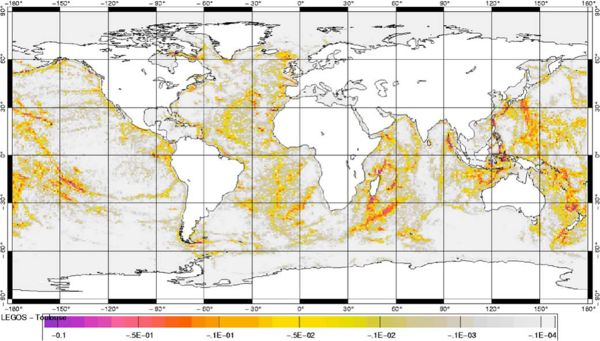Internal tides
Internal tides are tidal waves created by the bottom topography. They propagate at the interfaces between ocean layers. As for classical altimetry, tides , for wide-swath altimetry are an object of study as well as a correction to remove both. The Swot orbit has been chosen to avoid aliasing of the main tidal constituents: regular observations will able to discriminate them over the 3 years of the mission. The 2D capability of Swot, and its high resolution, also enable the mapping of internal tides.

Internal tides are tides created in a stratified ocean by the interaction of the external tide with sharp bathymetric gradients. They propagate at the interfaces between ocean layers. The internal tides surface signature can reach several centimeters in some locations.
As with conventional altimetry, the tides observed with the Swot wide-swath altimetry are both an object of study as well as a correction to remove to observe the non-tidal ocean dynamics. The Swot orbit has been chosen to avoid aliasing of the main tidal constituents: regular repeat observations will able to discriminate between them over the 3 years of the mission. Swot has a lower noise level than conventional altimetry, and combined with its high 2D spatial resolution, also enables the mapping of coherent internal tides globally, as they radiate out from bathymetric structures
Previously, most accurate approaches to compute the coherent internal tide SSH field were quasi-empirical. However, a suite of different internal-tide correction algorithms and models has been developped for Swot, and have been cross-compared. Efforts to develop internal-tide correction algorithms have also led to useful insights into how best to incorporate the Swot data into such models.
However, a significant fraction of the internal tide SSH variance is incoherent. Studies are underway to understand the degree to which open-ocean internal tides - and specifically their surface signature - maintain sufficient coherence in time to be amenable to prediction.

More information
- White paper : Tides and the SWOT mission: Transition from Science Definition Team to Science Team, Brian K. Arbic et al., Jan. 2015 (pdf)
- Lyard, F., Lefevre, F., Letellier, T., and Francis, O., 2006. Modelling the global ocean tides: modern insights from FES2004. Ocean Dynamics, 56:394–415, doi:10.1007/s10236-006-0086-x.
- Shriver, J. F., J. G. Richman, and B. K. Arbic, 2014: How stationary are the internal tides in a high-resolution global ocean circulation model?, J. Geophys. Res. Oceans,119, 2769–2787,doi:10.1002/2013JC009423.
- Zhao, Z. and M. H. Alford 2009: New Altimetric Estimates of Mode-1 M2 Internal Tides in the Central North Pacific Ocean. J. Phys. Oceanogr. 39, 1669–1684, DOI: 10.1175/2009JPO3922.1




